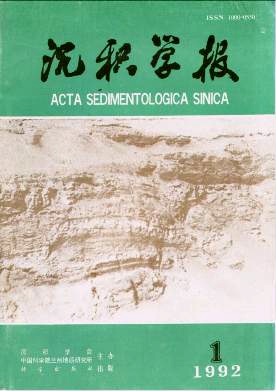Zhao Jiangtian, Yang Fengqing. Permian Sedimentary Features and Environmental Analysis of Maomaolong Formation in Malonggou Xiahe, Gansu[J]. Acta Sedimentologica Sinica, 1992, 10(1): 47-56.
| Citation:
|
Zhao Jiangtian, Yang Fengqing. Permian Sedimentary Features and Environmental Analysis of Maomaolong Formation in Malonggou Xiahe, Gansu[J]. Acta Sedimentologica Sinica, 1992, 10(1): 47-56.
|
Permian Sedimentary Features and Environmental Analysis of Maomaolong Formation in Malonggou Xiahe, Gansu
- Received Date: 1990-03-02
- Publish Date:
1992-03-10
-
Abstract
The Permian depositional environment of Maomaolong Formation in Malonggou is hot point in the research of West Qingling Mountains, this paper deals with it in detail and four physical characteritics were distinguished: 1. Carbonate debris and turbidite, consisting of conglomeratic carbonate rock. The turbidite has an incomplete Bouma sequence with graded bedding and paralled stratification. 2.Clastic debris, turbidite and grain flow sandstone, consisting of conglomerate, gravel sandstone, siltstone and slate. The turbidite has a complete Bonma sequence with gutter cast, graded bedding, small hummocky crossbedding and horizontal stratification. The grain flow sandstone has reverse-graded bedding. S.Contourite, consisting of siltstone and silty slate with horizontal stratification and water-current ripple. The direction of water-current is 97° -107°, being vertical with the direction of turbidite. 4. Normal deep-sea sediments of non-gravity current, consisting of silty slate, and the small horizontal stratification being found occasionally. Seven chemical compositions of mudstone from normal deep-sea, sediments have been determined, they were analysed to be similar to the modern deep-sea sediments. TiO2 / Al2O3 values of Malonggou section decrease with the decrease of depth showing the depositional environment was departing from the continental region. A trace fossil association of Neonereites- Protopaleodictyon. was established which has the ecdogical characters of slope environment. According to the above-mentioned sedimentary feature, the late Early Permian to Late Permian slope environment of Maomaolong Formation was resumed. The depositional basin continued subsiding with the splitting of Paleo-Qinling trough, and developed to a slope foot-basin environment in late Late Permian. The direction of gutter casts (320 ° -340 ° ) and the distribution of the conglomeratic carbonate rock indicate that the slope was inclined to south at that time, belonging to the Northern Slope of the Paleo-Qinling trough. And the angle of the slope was calculated to be 1 ° or 2 ° to 18 °, and had the tendency of getting smaller in the lower slope.
-
References
|
[1]
|
(1) 左国朝、金松桥、朱伟元,1984,沉积学报,2卷,3期,75-81页
(2) 冯益民、朱宝清,1980,地质学报,54卷,1期.34-42页
(3) 金若谷、黄恒锉,1987,古生物地层论文集,第十八辑,32-65页
(4) 高振中、刘怀波,1983,石油与天然气地质,4卷,1期,53-65页
(5) 贾振远,1988,石油与天然气地质,9卷,2期,171-177页
(6) 虞子治、施央申、郭令智,1989,沉积学报,7卷,3期,21-28页
(7) Cronan, D.S.. 1977, Geochemical Investigations on Sediments from the Mid-Atlantic Ridge: Leg37, Deep Sea Drilling Project. In: Init. Rpts. Deep Sea Drilling Proj. 37, p.631-632
(8) Ekdale, A.A., 1977, Abyssal Trace Fossils in Worldwide Deep Sea Drilling Project Cpres. In: Crimes, T.P. and J.C. Harper ed. Trace Fossils 2, p.162-182
(9) Ekdale. A.A., 1978, Trace Fossils in Leg42A Cores, Init. Rpts. Deep Sea Drilling Proj. 42, p.821-829
(10) Faugeres, J. C. et al. 1984, Contourite Drift Molded by Deep Mediterranean Outflow. Geology. V.12 N.5. p.296-300
(11) Kolla, V. and Macurda Jr. V.B. 1988, Sea-Level Changes and Timing of Turbidity-Current Events in Deep-Sea Fan Systems. In: Sea-Level Changes-An Integrated Approach. SEPM Special Publication N.42, p.381-392
(12) Schmitz, B.,1987, The Tio2 / Al2O3 Ratio in the Cenozoic Bengal Abyssal Fan Sediments and its Use as a Paleostream, Marine Geology, V.76 N.3, p.195-206
(13) Stow, D.A.V. and Lovely J.P.B., 1979,- Distinguishing between Fine-Grained Turbidites and Contourites on the Deep-Water Margin off Nova Seatia, Sedimentology, 26, p.371-387
(14) Stow, D.A.V. 1985, Deep-Sea Clastics: Where are We and Where We,Going? In: Sedimentology: Recent Developments and Applied Aspects, ed. by Brenchley, P.J. and Williams, B.P.1. (18), p.67-93. |
-
-
Proportional views

-






 DownLoad:
DownLoad: